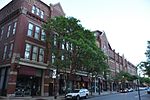Free State Project
The Free State Project (FSP) is an American political migration movement founded in 2001 to recruit at least 20,000 libertarians to move to a single low-population state (New Hampshire was selected in 2003) in order to make the state a stronghold for libertarian ideas. The New Hampshire Union Leader reports that the Free State Project is not a political party but a nonprofit organization.Participants of the FSP signed a statement of intent declaring that they intended to move to New Hampshire within five years of the drive reaching 20,000 participants. This statement of intent was intended to function as a form of assurance contract. As of February 3, 2016, 20,000 people have signed this statement of intent, completing the original goal, and 1,909 people are listed as "early movers" to New Hampshire on the FSP website, saying they had made their move prior to the 20,000-participant trigger. In the 2017–2018 term of the 400-member New Hampshire House of Representatives, 17 seats were held by Free Staters.The FSP is a social movement generally based upon decentralized decision making. The group hosts various events, but most of FSP's activities depend upon volunteers & no formal plan dictates to participants or movers what their actions should be in New Hampshire. As of May 2022, approximately 6,232 participants have moved to New Hampshire for the Free State Project.
Excerpt from the Wikipedia article Free State Project (License: CC BY-SA 3.0, Authors).Free State Project
Elm Street, Manchester
Geographical coordinates (GPS) Address Nearby Places Show on map
Geographical coordinates (GPS)
| Latitude | Longitude |
|---|---|
| N 42.9897 ° | E -71.4634 ° |
Address
Elm Street 814
03101 Manchester
New Hampshire, United States
Open on Google Maps









